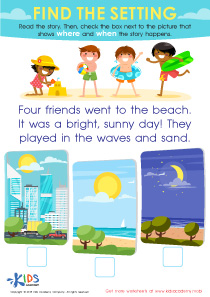Visual discrimination Easy Worksheets for Ages 3-6
5 filtered results
-
From - To
Introduce your little learners to the magic of exploring differences with our easy visual discrimination worksheets, designed for ages 3-6! At Kids Academy, we harness fun, colorful exercises to develop young minds in recognizing shapes, sizes, patterns, and details. Our expertly crafted activities enhance attention to detail and critical thinking, paving the way for academic success. Tailored for early learners, each worksheet captivates curiosity and promotes hands-on learning. Ideal for classrooms and at-home education, these resources prepare your child for reading and math adventures. Unlock the joy of learning with Kids Academy's engaging visual discrimination worksheets today!


Tall or Short and Heavy or Light? Worksheet


Name the Shapes Halves or Fourths? Worksheet


What Matches the Picture? Worksheet


What Shape Am I? Worksheet


What Does Not Match? Worksheet
Visual discrimination is the ability to recognize details in visual images. For children aged 3-6, developing this skill is crucial for early learning and everyday functioning, and both parents and teachers should prioritize it.
First, visual discrimination is foundational for reading and writing. It helps children differentiate between similar letters and words (like 'b' and 'd', or 'fun' and 'run'), which is essential for literacy development. Without accurate visual discrimination, children may struggle with recognizing words or making sense of the written language.
Second, in mathematics, visual discrimination aids in recognizing numbers and shapes. Being able to identify patterns and differences in objects is fundamental for early math skills, such as counting, sorting, and understanding mathematical concepts.
Moreover, good visual discrimination skills support other cognitive tasks, such as memory and attention to detail. These skills are not only academic but also play a role in daily activities—like identifying objects, playing games, and even getting dressed (e.g., choosing matching clothes).
Engaging children in activities like puzzles, matching games, and sorting exercises can significantly enhance their visual discrimination skills. By fostering this development, parents and teachers help build a strong foundation for future learning and daily problem-solving, ensuring children are equipped with the tools they need for academic success and life.
 Assign to My Students
Assign to My Students















